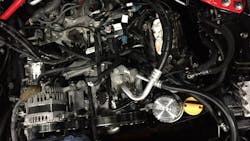Tech Tip: Extend oil change intervals by implementing oil analysis
Oil change is probably the most important component in a fleet owner’s list of preventive maintenance items. And, depending on its frequency, it is likely to be among the most expensive.
Advancements in oil and filter technology have extended oil change intervals in vehicles, busting the myth of needing to change the oil and filter every three months or every 3,000 miles.
“For fleets, extending oil change frequency can easily translate into thousands of dollars in cost savings, provided the fleet manager pairs the right oil with the right filter at the right change interval for the right vehicle,” said Scott Killips, CEO, HUBB Filters. “Determining the ’right change intervals‘ is key to cost effective oil change management and oil analysis can take out the guesswork by telling you how well the oil and filter are protecting the vehicle and if the oil’s properties are still viable. But, a common problem we see is that the oil filter is holding back the performance of the oil and the ability of the fleet manager to extend the life of the oil.”
“Recent developments in oil filter technology, now make it possible to pair an oil filter with oil that collectively enable you to safely extend the oil’s life," Killips said. "But, use oil analysis to remove the guesswork.”
Oil analysis machines don’t come cheap, but the advantages they offer have allowed some fleets to justify the expense. In addition to helping a fleet manager judiciously extend the fleet’s oil change interval, oil analysis machines enable one to objectively measure the performance of the oil and filter combination in a vehicle. This enables the fleet manager, to determine when it is time to change the oil and filter to avoid an engine breakdown.
If you don’t have an oil analysis machine, use a sampling technique to develop an oil analysis plan for your fleet. It is not necessary to conduct an oil analysis each time you perform an oil change on a vehicle; that’s where the sampling technique comes into play.
Oil analysis should be an ongoing element of your fleet management protocol and can save a fleet manager a significant amount of money while providing the comfort of knowing that your fleet is not at risk.
Information provided by: HUBB Filters
